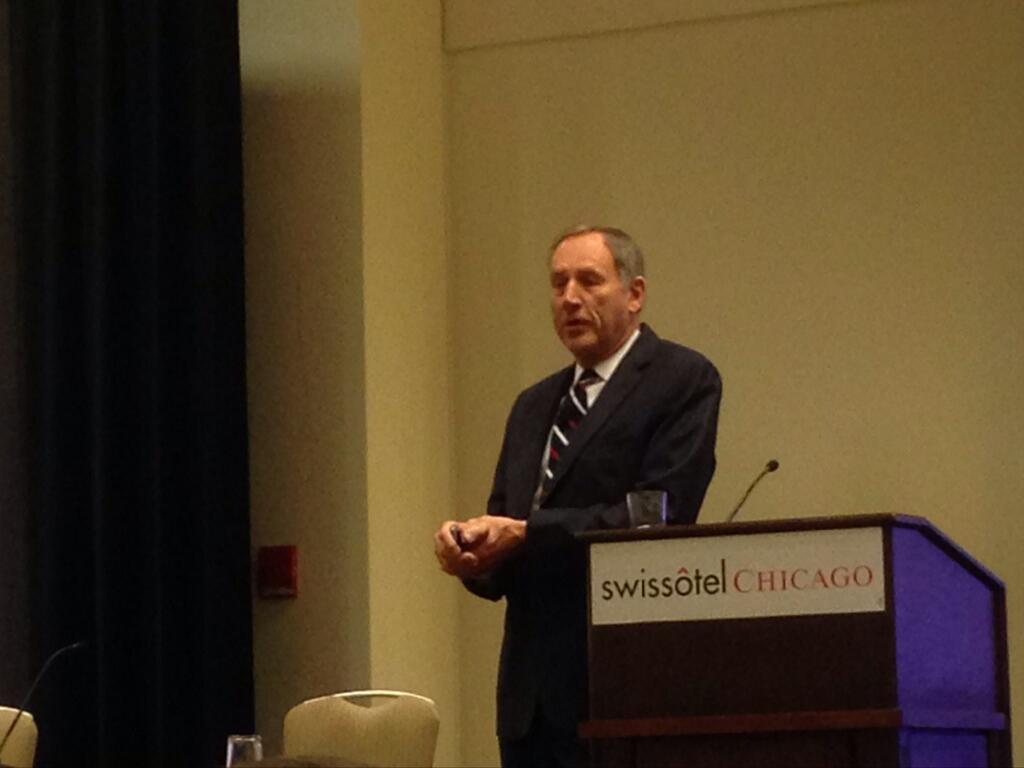The term "crisis" in Chinese is comprised of two characters. When read separately, they mean "risk" and "opportunity."
 For Toby Cosgrove, MD, president and CEO of Cleveland Clinic, healthcare today is viewed as being mired in a crisis, but it will be defined by risk and opportunity. Dr. Cosgrove was a keynote speaker at the Becker's Hospital Review 5th Annual Meeting in Chicago on May 16, and he gave healthcare leaders a sense of what his organization is doing to cope with those two factors.
For Toby Cosgrove, MD, president and CEO of Cleveland Clinic, healthcare today is viewed as being mired in a crisis, but it will be defined by risk and opportunity. Dr. Cosgrove was a keynote speaker at the Becker's Hospital Review 5th Annual Meeting in Chicago on May 16, and he gave healthcare leaders a sense of what his organization is doing to cope with those two factors.
Providers are facing a buffet of "disruptors" and risks, Dr. Cosgrove said. Moving from volume-based reimbursement to value-based, massive cuts to Medicare and healthcare research funding, high-deductible health plans, a shortage of physicians, consolidation, healthcare transparency — responding to these "tremendous changes" is what makes the profession both exciting and nerve-wracking, he said.
Cleveland Clinic has turned those risks into opportunities for growth. For example, the organization is handling the physician shortage by engendering a sense of loyalty. Six years ago, Cleveland Clinic became the first tuition-free medical center in the country, a big deal for physicians who take on an average of $160,000 of debt to go through medical school. "This is our investment and our intellectual capital for the future," Dr. Cosgrove said, noting that physicians are also offered jobs at Cleveland Clinic after their training.
Other opportunities Cleveland Clinic has focused on include IT venture capital funding for new, emerging technologies. These include its spin-off company, Explorys, which helps manage and make sense of big data. IBM's Watson is also "attending" Cleveland Clinic's medical school, helping clinicians with evidence-based decision-making. "He's a very good student, but not much fun on Saturday night," Dr. Cosgrove said. "But [these technologies] give us the ability to take tremendous amounts of data — which is doubling every two years — and help us as clinicians to make decisions that are appropriate for our patients."
Cleveland Clinic has also taken steps to bring care coordination to new heights: heart and vascular affiliations, a strategic partnership with Community Health Systems, a for-profit hospital chain in Franklin, Tenn., direct-to-employer relationships for certain specialties like cardiology and orthopedic care, expansion into Abu Dhabi and other international sites.
The health system is able to be on the cutting edge of new strategies and ideas because of its size and scope, but all providers should be focused on three key items, Dr. Cosgrove said: improving access, improving quality and decreasing costs — a similar vein of healthcare's triple aim.
Cleveland Clinic has worked to improve access to healthcare by partnering with CVS and other retail health clinics, embracing telehealth services that virtually connect clinicians and patients, and ensuring patients can see physicians on the same day they call in. On quality, Cleveland Clinic publishes all clinical outcomes — "the good, the bad and the ugly."
"I think this is our obligation to the community we serve, to be transparent around our quality," Dr. Cosgrove said. "This is not an easy process. We've invested heavily in this. It causes us to keep data, look at data, and causes us to do it better."
The last piece, decreasing costs, has been a sticking point for many hospitals and health systems. At Cleveland Clinic, every institute and service line examines their processes to see where costs can be pulled out. For example, the system has cut the costs of partial nephrectomies by 20 percent simply by mapping out what elements get inflated throughout the procedure. Cleveland Clinic also relies on its employees to find cost savings. Two employees found that some prep soap and solution bottles were only being half-used. Reducing the size of the bottles cut out waste and saved the organization more than $300,000, Dr. Cosgrove said.
It's those employees, or caregivers, that have also been the lifeblood of the organization.
"We don't think that you can get great patient service without engaged caregivers," Dr. Cosgrove said. "We refer to everyone who works at Cleveland Clinic as a caregiver. It doesn't matter if you're a neurosurgeon or someone who works in the loading dock. We've worked hard at improving this."
Dr. Cosgrove concluded by showing a Cleveland Clinic-produced video that has since gone viral. At the heart of the video, and Cleveland Clinic's mission, is the patient perspective, he said. If a healthcare organization abides by that creed and truly puts the patient first, beyond the lip service of a mission statement, success will almost always follow.
More Articles on Becker's Hospital Review 5th Annual Meeting:
The Impact of Healthcare Reform on Hospitals and Health Systems
Where Should Healthcare Leaders Focus Their Energies Now?
Key Financial and Strategic Issues: 3 Health System Leaders Weigh in

